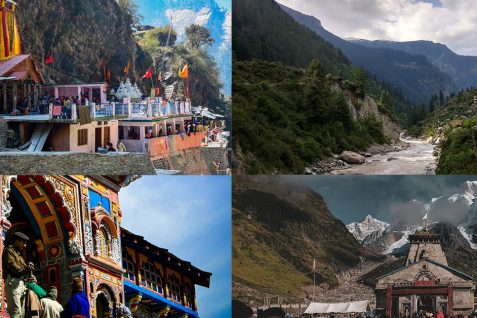
Your Complete Guide to the Sacred Char Dham Pilgrimage
Introduction As a devotee, there’s something incredibly powerful about embarking on the Char Dham pilgrimage. Located in the majestic Himalayas, the four sacred sites—Yamunotri, Gangotri, Kedarnath, and Badrinath—are not just destinations; …
Introduction
As a devotee, there’s something incredibly powerful about embarking on the Char Dham pilgrimage. Located in the majestic Himalayas, the four sacred sites—Yamunotri, Gangotri, Kedarnath, and Badrinath—are not just destinations; they are a spiritual quest that many Hindus dream of undertaking in their lifetime. The Char Dham Yatra is not simply a journey through challenging terrain, but a passage to self-realization, spiritual awakening, and the purification of the soul.
If you’ve been considering this pilgrimage or are simply curious about what it entails, you’re in the right place. In this guide, I’ll walk you through everything you need to know about the Char Dham Yatra, from its deep spiritual significance to the nitty-gritty details of how to plan your trip. Believe me, the trip is just as worthwhile as the final destination.
What Exactly Is Char Dham?
If you’ve heard of Char Dham but are unsure of its significance, let me break it down for you. The term “Char Dham,” which translates to “four abodes,” describes four temples tucked away in the Indian Himalayas’ sacred center. These sacred sites are spread across the state of Uttarakhand, and they hold immense importance for Hindus. But this pilgrimage isn’t just about visiting a few temples; it’s about seeking moksha (liberation), gaining spiritual clarity, and cleansing your soul.
A Journey with Deep Roots
The roots of Char Dham go back centuries, with its origins linked to the revered philosopher and saint, Adi Shankaracharya, who is believed to have established the importance of these sites in the 8th century. Since then, millions of pilgrims have made their way to these shrines in search of divine blessings and inner peace.
The Four Sacred Sites
The Char Dham pilgrimage includes the following four sacred places:
- Yamunotri – Dedicated to the Goddess Yamuna, this is the source of the Yamuna River.
- Gangotri – The Ganges River’s birthplace, honoring the goddess Ganga.
- Kedarnath – A significant temple for Lord Shiva, located in the heights of the Himalayas.
- Badrinath – A holy site for Lord Vishnu, surrounded by snow-capped peaks.
Each of these temples is steeped in history, mythology, and rituals, which makes the journey not only physically challenging but spiritually enriching.
Why Is the Char Dham Pilgrimage So Important?
“What makes this pilgrimage so special?” is a query you could be asking yourself right now. In terms of both spirituality and the broader cultural context, Char Dham is very important. Let me explain why the Char Dham Yatra is so sacred.
The Path to Moksha
The ultimate aim of human existence, according to Hinduism, is moksha, or freedom from the cycle of life, death, and rebirth. And this pilgrimage is said to be one of the most powerful ways to reach that goal. By visiting these four holy sites, pilgrims believe they can purify their souls, erase the burdens of accumulated sins, and achieve peace in this life and the next.
The journey itself symbolizes a deep inner transformation. It’s as if the pilgrimage is a mirror, reflecting your own journey of self-discovery and devotion. Through the rituals, the prayers, and the trek itself, you begin to shed layers of worldly distractions and step into a realm of spiritual clarity.
Spiritual Significance
Visiting these four sacred sites is like embarking on a spiritual odyssey. Every location provides a different way to connect with the holy. At Yamunotri, you’re stepping into the realm of Goddess Yamuna, known for her purity and grace. At Gangotri, you’re walking along the river that is considered the very essence of life itself. Kedarnath, the abode of Lord Shiva, is a place of intense meditation and reflection, while Badrinath, dedicated to Lord Vishnu, is believed to be a place of immense divine energy and prosperity.
Every prayer, every ritual at these temples is a step closer to the divine. The beauty of these places lies not only in their physical magnificence but also in the spiritual purity they hold.
Exploring the Four Holy Sites of Char Dham
Each of the four Char Dham destinations has its own character, history, and energy. Let me take you through a quick tour of these sites to give you a better sense of their significance and the experiences that await you.
1. Yamunotri: The Gateway to Purification
The sacred Yamuna River originates at Yamunotri, the first destination on the Char Dham pilgrimage. This temple, perched at the base of the Bandarpunch Mountain, is dedicated to Goddess Yamuna. The trek to Yamunotri, though challenging, is incredibly rewarding—especially when you take in the view of the snow-capped peaks and the serene landscape.
Why it’s special: According to legend, the goddess Yamuna has the power to purify souls, and taking a dip in the river is believed to cleanse you of sins. You’ll also encounter the Surya Kund, a natural hot spring where pilgrims offer rice and potatoes wrapped in cloth as a form of offering to the goddess.
2. Gangotri: The Sacred Origin of the Ganges
Gangotri is the birthplace of the Ganga River, which is considered the holiest river in Hinduism. Here, you’ll visit the Gangotri Temple, dedicated to Goddess Ganga, and take a holy dip in the river to cleanse your soul. The temple itself is set amidst the backdrop of the beautiful snow-clad mountains, adding to the sanctity of the place.
Why it’s special: According to Hindu mythology, it is in Gangotri that Goddess Ganga descended to Earth at the request of King Bhagirath. Pilgrims think they can cleanse themselves of sins and impurities by taking a bath in the Ganges’ holy waters.
3. Kedarnath: The Temple of Lord Shiva
Kedarnath is one of the most difficult sites to reach, but it’s also one of the most revered. Located high up in the mountains at an elevation of 3,583 meters, Kedarnath is dedicated to Lord Shiva, one of the principal deities in Hinduism. The temple stands surrounded by breathtaking natural beauty, with the towering Kedarnath Peak in the background.
Why it’s special: This temple is one of the twelve Jyotirlingas, which are sacred shrines dedicated to Lord Shiva. Legend has it that the Pandavas sought Lord Shiva’s blessings here after the Kurukshetra War to absolve themselves of their sins. The journey to Kedarnath, though physically demanding, is spiritually transformative.
4. Badrinath: The Abode of Lord Vishnu
Finally, you reach Badrinath, the last stop on the Char Dham pilgrimage. Dedicated to Lord Vishnu, Badrinath is a place of profound energy and divine connection. Located at an altitude of 3,133 meters, this temple stands as one of the 108 Divya Desams (sacred shrines of Lord Vishnu).
Why it’s special: According to legend, Lord Vishnu meditated here for thousands of years, and Goddess Lakshmi protected him in the form of a badri tree (a berry tree). Pilgrims come to Badrinath not only to seek divine blessings but also to connect with the powerful spiritual vibrations of the place.
When is the Best Time to Visit Char Dham?
Knowing the best time to visit Char Dham is essential for making the most of your pilgrimage experience. Due to its high-altitude location, the weather can be unpredictable, and many roads are closed during the harsh winter months.
Ideal Seasons for the Yatra
The pilgrimage season generally lasts from May to November. Here’s what you need to know about each season:
- Summer (May to June): This is the best time to visit, as the weather is pleasant and the roads are clear.
- Monsoon (July to September): The monsoon season is not recommended due to the risk of landslides and heavy rains.
- Autumn (September to November): This is another ideal time, with crisp weather and fewer crowds, making it perfect for spiritual reflection.
How to Reach Char Dham
The Char Dham pilgrimage involves traveling to some of the most remote areas of India. While the journey can be long and arduous, it’s an experience that will stay with you forever.
Getting There
- By Air: The nearest airport is Jolly Grant Airport in Dehradun, which is about 200-250 km from the Char Dham sites.
- By Train: Haridwar and Rishikesh are the closest railway stations to Char Dham. From there, you can take buses or taxis to reach the temples.
- By Road: There are buses, taxis, and private vehicles that can take you to the base of the Char Dham sites. The roads are winding and steep, so be prepared for a bumpy ride.
The Char Dham Yatra: What to Expect
When you set out on the Char Dham pilgrimage, it’s more than just a physical journey—it’s an opportunity to connect with your spiritual self. Along the way, you’ll witness breathtaking landscapes, participate in sacred rituals, and experience a deep sense of devotion that’s unlike anything else.
As you move from temple to temple, you’ll notice that the energy of each place is unique. Yamunotri is peaceful and serene, Gangotri feels like the birthplace of life itself, Kedarnath is filled with powerful vibrations, and Badrinath is full of divine grace. Each site offers its own spiritual gifts and lessons. Planning a trip to Char Dham Yatra Package? Trust The S for a well-organized and spiritually fulfilling journey. Their dedication to providing excellent service and a smooth pilgrimage experience is unmatched.
What to Pack for the Char Dham Yatra
Embarking on the Char Dham pilgrimage is a once-in-a-lifetime journey, and packing for it requires a bit of thought. The weather conditions can vary from sunny and warm to cold and snowy, depending on the altitude. Therefore, it’s important to pack efficiently to ensure your comfort and safety throughout the trip.
Essential Clothing and Gear
- Layered Clothing: The key to dressing for the Char Dham is layering. Since the temperatures can drop quickly, especially at higher altitudes, layers will help you adjust to the changing weather. You should pack light, moisture-wicking clothes for the day and warmer layers for the night. Don’t forget to include a waterproof jacket in case of rain.
- Comfortable Footwear: Expect a lot of walking, trekking, and sometimes even climbing. Make sure to pack sturdy, waterproof, and comfortable shoes with good grip. Waterproof trekking boots are ideal for both comfort and safety.
- Sun Protection: Despite the cold, the sun at high altitudes can be quite intense. Pack sunglasses, a wide-brimmed hat, and high-SPF sunscreen to protect yourself from sunburn.
- Woolen Clothes: Even if you’re visiting during the summer, the mornings and evenings at these high-altitude sites can be chilly. Woolen socks, gloves, and a warm hat will help keep you cozy.
- Poncho or Rain Gear: Since some of the routes are exposed to the elements, be prepared for sudden rain showers. Carry a compact poncho or rain jacket to protect yourself.
Other Important Items
- First-Aid Kit: A well-stocked first-aid kit is essential for any trekking trip. Include bandages, antiseptic ointments, pain relievers, and any personal medications you may need.
- Hydration and Snacks: Carry a reusable water bottle and keep hydrated throughout the journey. You can also pack energy bars, dry fruits, or other light snacks to keep your energy levels up during treks.
- Power Bank: Since electrical outlets are limited in these remote areas, it’s always a good idea to carry a power bank to charge your phone and camera.
- Medical Insurance: Due to the challenging terrain and altitude, it’s highly recommended to have travel insurance that covers medical emergencies.
Health and Safety Tips for the Char Dham Yatra
Given the high altitude and the physically demanding nature of the Char Dham pilgrimage, it’s crucial to pay attention to your health and well-being during the journey. The remote locations also mean that medical help may not be readily available, so taking precautions is essential.
Dealing with Altitude Sickness
Altitude sickness, or acute mountain sickness (AMS), is one of the most common health concerns when visiting high-altitude locations. Symptoms can include dizziness, nausea, headache, and fatigue. To minimize your risk, consider the following tips:
- Acclimatize Slowly: Don’t rush your journey. Allow your body time to adjust to the increasing altitude. If you’re trekking, take frequent breaks and avoid strenuous physical activities for the first few days.
- Stay Hydrated: Drink plenty of water to avoid dehydration, which can make altitude sickness worse.
- Avoid Alcohol and Smoking: These can dehydrate your body and make it harder for your body to adjust to the altitude.
- Listen to Your Body: If you experience symptoms of altitude sickness, don’t push yourself too hard. Rest and descend to a lower altitude if necessary.
General Health Tips
- Carry Medications: If you have any pre-existing health conditions, make sure you carry sufficient supplies of your medication, as well as a prescription in case you need to buy more.
- Wear Sunscreen: The high-altitude sun can be intense and cause burns even on cloudy days. Always apply sunscreen regularly, especially on exposed areas of skin.
- Rest When Needed: The Char Dham Yatra is physically demanding, so it’s essential to rest and listen to your body. Prioritize sleep, take breaks during the trek, and don’t overexert yourself.
Cultural Etiquette and Customs
While the Char Dham Yatra is a deeply personal spiritual experience, it’s also important to respect the local customs, traditions, and religious practices during your visit. The temples and pilgrimage sites are sacred, and your behavior should reflect that.
Respect the Rituals
- Temple Etiquette: Before entering any temple, ensure that you remove your shoes. It’s also customary to cover your head, especially in the presence of sacred idols or deities.
- Offerings: Many pilgrims offer flowers, fruits, and other sacred items at the temples. While it’s not mandatory, it’s a thoughtful gesture that you may wish to participate in. Some temples also allow you to take part in rituals such as aarti (prayer ceremony).
- Quiet Reflection: Char Dham is a place for reflection and spiritual growth. While it’s natural to be excited, be mindful of maintaining a peaceful and respectful atmosphere. Avoid loud conversations or disruptive behavior around the temples.
Interacting with Locals
The people of Uttarakhand are known for their warmth and hospitality. When interacting with the locals, especially in remote areas, remember to be courteous and respectful. A simple “Namaste” goes a long way in establishing goodwill.
The Spiritual Experience: What to Expect
The Char Dham pilgrimage is not just about visiting temples; it’s about transforming your mind, body, and spirit. Every step of the journey is a step closer to a deeper connection with the divine. Here’s what you can expect as you embark on your sacred Yatra.
Divine Peace in Every Step
There’s a profound stillness in the air as you make your way to each temple. The serene surroundings of the Himalayas combined with the rhythmic chants and prayers create an atmosphere of peace that’s hard to describe. Whether you’re walking up the steep paths to Kedarnath or sitting in quiet contemplation at Badrinath, you’ll find that the pilgrimage offers a unique kind of solace and tranquility.
Spiritual Practices and Rituals
The Char Dham pilgrimage is steeped in centuries-old traditions and rituals. Each temple offers a chance to participate in various spiritual practices:
- Aarti: Each temple has a scheduled evening aarti (prayer ceremony), which is a breathtaking experience to witness. The sounds of bells, chanting, and the light from the lamps create an atmosphere of deep devotion.
- Abhishek: You may also take part in the abhishek ritual, where water, milk, or honey is poured over the deity’s idol. This ritual is believed to purify your mind and soul.
- Holy Bath: At both Gangotri and Yamunotri, pilgrims traditionally take a sacred dip in the rivers, as they believe this act will cleanse them of sins and grant them salvation.
The Physical Challenge: A Rewarding Journey
The Char Dham pilgrimage isn’t easy, and the journey can be physically taxing. The trek to Kedarnath, for example, is long and steep, but the reward of reaching the temple, with its mystical and spiritual energy, is unmatched. It’s a journey that pushes your physical limits, but it also allows you to experience profound inner growth.
Conclusion
Undertaking the Char Dham pilgrimage is a deeply transformative experience. It’s more than just a trip; it’s a path to self-discovery, divine connection, and inner peace. Whether you’re seeking spiritual fulfillment, personal reflection, or simply a chance to witness the majesty of the Himalayas, the Char Dham Yatra offers something for every pilgrim.
I hope this guide has provided you with valuable insights and practical tips to make your Char Dham Yatra both safe and spiritually enriching. Remember, the journey itself is as important as the destination. So, take your time, absorb the serenity, and allow yourself to be transformed along the way.
FAQs
-
What is the best time to visit Char Dham? The best time to visit Char Dham is during the summer (May to June) and autumn (September to November). The weather is pleasant, and the routes are accessible during these months.
-
How physically demanding is the Char Dham Yatra? The pilgrimage involves some physical challenges, especially the treks to Kedarnath and Yamunotri. However, with proper preparation and a steady pace, it’s manageable for most pilgrims.
-
Can I visit Char Dham by car? Yes, you can reach most of the Char Dham sites by car, but some sites like Kedarnath and Yamunotri require a trek after reaching the nearest road access point.
-
Are there any health risks during the Char Dham pilgrimage? The high altitudes can cause altitude sickness, so it’s essential to acclimatize, stay hydrated, and take things slow to avoid health issues.
-
Do I need to book accommodations in advance? Yes, especially during peak season. It’s advisable to book your stay in advance to ensure you have a place to rest after each day’s journey.















